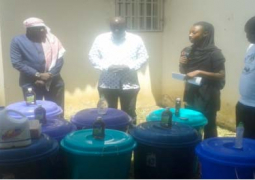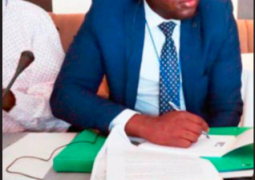Born 1913 - Died May 2011,
Teacher from 1932-1969
Mary Owens was born in Bathurst in 1913. She attended Wesley School and later the Methodist Girls’ High School (MGHS) until 1931. From 1932 to her retirement in 1969, she taught at various schools in Bathurst under the Methodist Mission. She was among the pioneer crop of female Gambian teachers in the 1920s and 1930s together with greats like Rosamond Fowlis, Miss Richards, who were also role models to numerous Gambian women who aspired for careers. It was my utmost pleasure to interview Mary at her residence in Kololi on 14 July 2010, assisted by another historian, Patience Sonko Godwin.
As historians, women achievers and pioneers like Mary deserve our constant attentionin order that their lifetimes and careers could be adumbrated to help inspire young women of today, and shape role models for our dear country, The Gambia.
Early Life: ‘ I was born in 1913, to a carpenter father and an educated house wife mother. I attended ABC (nursery) at Wesley School and later proceeded to complete my Standard Six in 1929. In that year I got a scholarship from Government to proceed to the Methodist Girls High School (MGHS) Intermediate class and later to High School which I completed in 1931. Then few girls were able to go beyond Standard Six because it was very expensive to pay for High School. Indeed, I was among the lucky few girls to proceed to High School. I can remember at Wesley School we paid 4 pence a month in the junior class as school fees and the amount rose as one moved higher up the Standards. Many parents could not pay for their children. Also, then only Christian girls went to school; Mohammedan (Muslim) girls did not go to school; instead attended the Koranic Dara. The first Wollof girls I knew who went to school included Sabelle Jagne, Jojo Jaw, who went to Muhamedan School under Master Wilson. But even though Wollof Muslim girls were not going to school, we Aku girls socialized with them. Really, few parents then valued girls’ education; many preferred to leave their daughters at home and taught them Home Craft in preparation for marriage.
Among my teachers at Wesley were Mrs Chow, and Master Baker, the father of Diana Christiansen, wife of former senior civil servant Eric Christiansen. At Wesley I learnt Hygiene, Domestic Science, Sewing and other sujects…’
Life at MHGS: MGHS then located on Dobson Street, in the late 1910s had a Kindergarten section, Transition or Intermediate section and the High School section. Reverend JC Faye, was one of my teachers at the MGHS, he taught me Drawing. School hours were 9 to 11 am and then from 12:30 to 3 pm. Discipline was strict. Late coming was not allowed and offending pupils were canned with the tambi or flower whip stick. The subjects at MGHS included European History, where we learnt about British kings and conquerors such as William the Conqueror; Shakespeare; English poetry, Music, Geography, Dictation, Spelling, P.E, Arithmetic and Writing. Music classes were only for those on scholarship as the others could not afford it. MGHS had a library, a netball court and to play cricket, we had to go to the McCarthy Square where there is a pitch for boys and girls. MGHS had famous principals like Miss Little, who in fact recommended me to be employed as a pupil teacher in 1932. I was paid a salary of 1 pound per month. It was Miss Morris and Ms Senior who introduced uniforms at MGHS: fawn top and pink blouse but this changed later to Blue…. Uniforms spread from MGHS to all Gambian schools.
Life as a teacher: ‘I was posted to Stanely Street School in 1932 and there I worked with the experienced Bolingbrook Fowlis, a famous teacher. I was there until 1940, when I was redeployed to MGHS my former school due to teacher shortage as most men were in the Second World War duties at the time.I was at MGHS until 1959 when I was made Headmistress of the Methodist Prep School, where I served till my retirement in 1969, after 37 years of service. In 1959 Government decided to amalgamate the MGHS and the Methodist Boys High School into Gambia High School, but the Methodist Prep and primary school was allowed to continue under my direction. In my time, teachers were seen as role models and so had to even watch whom they moved with. We knew where our pupils lived because classes were then small, 20 or 24 pupils in a class.’
Women’s associations in Bathurst: ‘I was member to many women’s social clubs at the time. I was active in Busy Bees, a philanthropic voluntary group formed by Miss Finn and led by wives of Colonial Governors such as Lady Southern and Lady Blood. Miss Rosamond Fowlis was secretary and when she was away I acted as Secretary. During the war, I was among the welcome committee for the returning demobilized soldiers from Burma. I can remember making a big banner with the words ‘Welcome Home’ and another banner with the worlds ‘We fought, we conquered’. These I hung across the street from the Carrol’s House. Also, I used to prepare pancake and ginger beer for sale to raise funds to buy things for the soldiers mpst of whom were sick and hungry. The Bees also visited the hospital to learn how to make bandages and other first aid techniques to enable us assist wounded soldiers. A Nissen Hut was put up at McCarthy Square equipped with a Library for the soldiers to relax in. Every Saturday we distributed cigarettes and tobacco to the soldiers.
There was the Ladies Guild for Catholic women. There was also the Ladies Choral Union at Bethel formed by TB Williams to perform the combined Methodist hymns. I was a member of the Tip Toe Club, a dance club led by Joe Clarke, Patrick Grant and Lucy Mensah. We organized dances and picnics during holidays. We danced from 1 to 6 pm, and as we grew older from 6 to 12 midnight. It was a mixed boys and girls club, but we were all Aku. We danced asiko.
Other social clubs in Bathurst were Lions Club, Reform Club of Sir John Forster, Indomitable of JC Faye and the Crystal Club of Mel Roberts and Grey Johnson. The Sierra Leone Boys had a club called Swansea.’
Other Remarks: ‘As head teacher I used to hold weekly staff meetings. I also used to step in for absent teachers… My former pupils are numerous; Kebba Foon, the accountant and nationalist politician; Dr Burang Goree Ndiaye, Taf Njie, Abigail Davies among hundreds others… I still sew my clothes and I am using a machine I got in 1956…. I was always busy teaching or doing church work… Jojo Cham, Fatu Sagnia, Sainabou Njie, Nyimasata Sanneh Bojang, were early Muslim girls of mine at the MGHS.’
Ms Owens died in May 2011.
Read Other Articles In Article (Archive)
Wuli West Parliamentarian Got It Right
Sep 11, 2009, 8:17 AM



